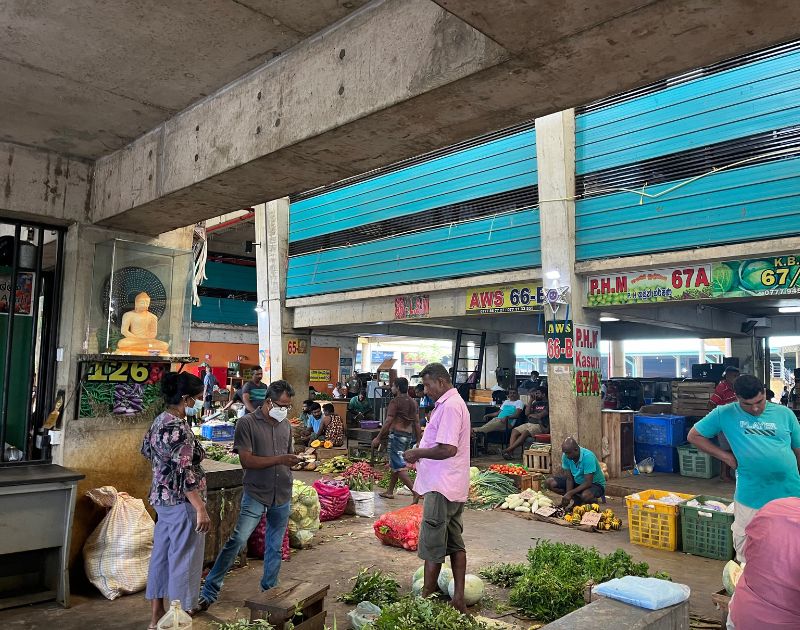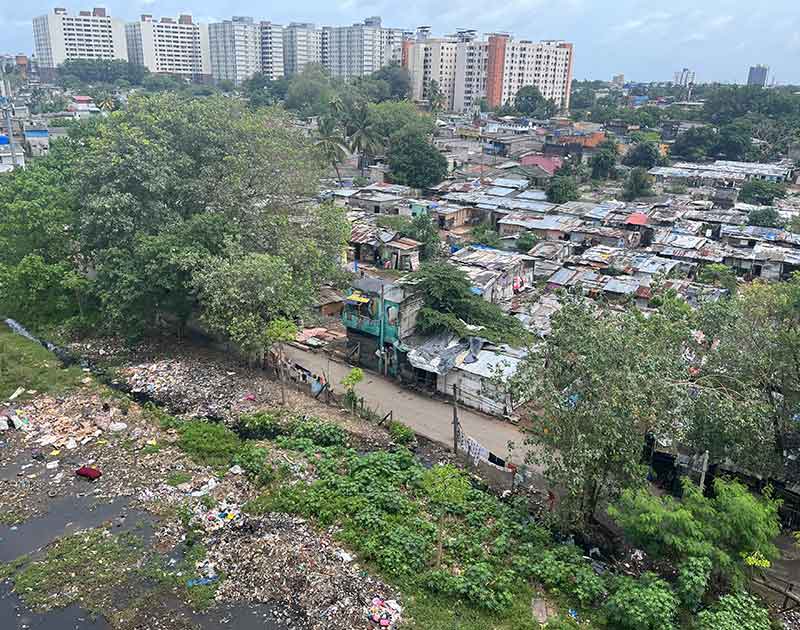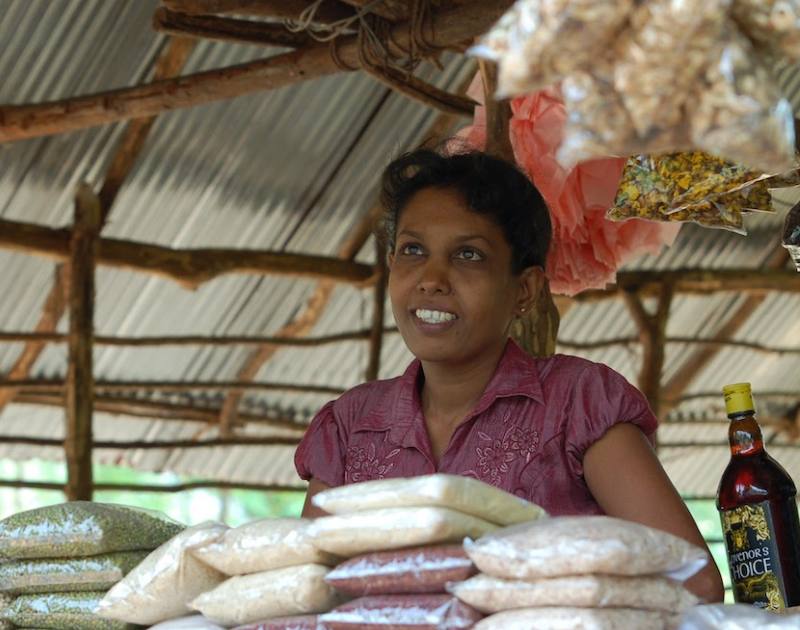
- Home
- Knowledge Insights
- Quantifying poverty: Can we truly capture its complexity?
Low income communities in Sri Lanka continue to face long standing structural inequalities compounded by the multiple crises which occurred over recent years. According to the estimates by the World Bank Group, poverty rates have drastically increased between 2021 and 2022 and are expected to remain above 25% in the coming years (World Bank Group, 2023). Meanwhile, the United Nations Development Programme’s (UNDP) ‘National Citizenship Survey 2022-2023’ estimates that 55.7% of Sri Lanka’s population is ‘multidimensionally vulnerable’ (UNDP, 2023 pp. 8).
In its Extended Fund Facility agreement with the International Monetary Fund (IMF), the government of Sri Lanka agreed to strengthen the country’s social safety nets (IMF, 2023a; IMF, 2023b). The Aswesuma cash transfer programme was a means by which the government aimed to address the shortcomings of the Samurdhi programme which preceded it. During the rollout process of Aswesuma, the capacities of both schemes to target poverty received a lot of attention.
This article was mainly motivated by a concern regarding whether the remarks made about the provisioning of Aswesuma and Samurdhi, are underpinned by a reductive overarching assumption about social safety nets in general. Where the concept of poverty is reduced to a characteristic that can be quantified by measuring a set of universally applicable indicators. Therefore, the inability of a particular rubric of indicators to significantly reduce false inclusions and exclusions is thought to be remediable by an alternative rubric of indicators.
At a broader level, this article hopes to provide a provocation to critically reflect on the confidence placed in the capacities of technical rational tools to definitively identify complex social phenomena (such as poverty).
Recent discussions about Sri Lanka’s social safety nets and their capacities to target poverty usually involved comparing different metrics to determine the legitimacy of the inclusion/exclusion of beneficiaries.
For example, according to World Bank (2022 p. x), in 2019, a little less than 49% of households within the poorest quintile received social assistance, while 12% of the richest quintile did as well. Specifically on the targeting capacities of Samurdhi, in 2019, the recipients represented 33% of Sri Lanka’s households, which is significantly higher than the estimated levels of poverty (DCS, 2016; Wanigasinghe, 2021). However, even though World Bank (2022 pp. 35) criticised Samurdhi’s targeting capabilities, it estimated that if not for such programmes, the poverty rate in 2022 would have been 28.7% instead of 25.6%. These shortcomings highlighted by World Bank (2022) were acknowledged by the IMF, which would later make amendments to its targeting capabilities a condition in the loan agreement it reached with the Government of Sri Lanka (IMF, 2023b).
Further criticisms were made by LIRNEasia, (2023) when sharing the findings of a recently conducted large-scale survey which led to the conclusion that only 40% of Samurdhi recipients were below the national poverty line (LIRNEasia, 2023). The study further concluded that only 31% of the poorest 10% and 4% of the richest 10% received Samurdhi benefits (LIRNEasia, 2023).
Even though the Chairman of the Welfare Benefits Board stated in June, 2023 that compared to its predecessor, the Aswesuma programme will see a nearly 22% increase in its coverage (Jabir, 2023), the increase in Aswesuma’s capabilities to target those in need should not be taken at face value.
The equitability of Aswesuma’s initial eligibility selection process was explored in a rapid study (published in June 2023), targeting the estate sector in two Grama Niladhari divisions (Kotagama, 2023). A key finding includes the change from Samurdhi to Aswesuma seeing a “larger drop of beneficiary % in the estate sector (15% drop) than in the rural sector (9% drop)”, despite the former having much higher levels of poverty (Kotagama, 2023).
Furthermore, according to an article published in the month of September, 2023, even though the Aswesuma programme managed to include 950,000 families which were not included in the Samurdhi programme, only 887,653 of the 1.28 million Samurdhi beneficiary families who applied to the Aswesuma programme were eligible for it (Wanigasinghe, 2023).
Even though in October 2023, the State Minister of Finance Shehan Semasinghe admitted to wrongful exclusions during the initial selection process, he expressed his confidence in it being a remediable issue (Economy Next, 2023b). Further confidence in the capacities of the “objective selection criteria” of the Aswesuma programme, and the promise of retroactive payments to those who experienced payment delays were made by President Ranil Wickremesinghe during his budget speech in November 2023 (Presidential Secretariat, 2023). However, it should be noted that the relevant “Application of Appeals and Objections” form (Welfare Benefits Board, n.d.) is mainly interested in verifying the original indicators/criteria. However, a field to include additional information was included with instructions to structure the response in under 50 words. President Wickremesinghe further promised to review the Aswesuma beneficiary list every 6 months to ensure new families whose circumstances have changed can be included into the programme (Presidential Secretariat, 2023). However, the fact that the chosen indicators/criteria may be blind to certain dimensions of poverty does not seem to have been considered.
Be that as it may, according to the Welfare Benefits Board’s webpage, as of the 10th of January, 2024, of the 3,744,494 applications received for Aswesuma, a little more than half were rejected (Welfare Benefits Board, n.d.). Furthermore, the number of appeals and objections received by the programme are numbered 1,028,885 and 134,540 respectively (Welfare Benefits Board, n.d.).
It is important to note that within this discourse around poverty estimates and targeted social safety nets, several different metrics have been used. The Aswesuma programme uses a Multi-dimensional Deprivation Scoring (MDS) method (using six criteria measuring 22 indicators) (Wanigasinghe, 2023; Hurulle, 2023; Ratnayake, 2023). The Samurdhi programme, on the other hand, used six indicators and a community-based assessment made by a committee comprised of people knowledgeable about the eligibility of applicants (DoSD, 2018; DoSD, 2021). Meanwhile, the Department of Census and Statistics uses a monetary approach that identifies a “person in poverty” as someone with a per capita expenditure per month below a particular threshold (DCS, 2022). Meanwhile, the World Bank uses USD 3.65 per capita per day (2017 PPP) as its poverty line indicator (World Bank, 2022; World Bank Group, 2023), and the UNDP used a “Multi-Dimensional Vulnerability Index” and “Incidence of Multidimensional Vulnerability” (UNDP, 2023 pp. 8).
This circles back to the initial concern about whether poverty can be quantified by measuring a set of universally applicable indicators. For, different institutions that are involved with estimating poverty and implementing interventions seem to prefer using different metrics. This warrants considering how operational definitions come into being and why they fail to grasp ground realities in their entirety.
Developing an operational definition for household poverty requires the consideration of two aspects. Firstly, it needs to identify an indicative property or combination of such properties which are generalisable across all households facing poverty (within the population of interest), and secondly, it needs to explain how they would be empirically measured and the degree of poverty calculated. According to the discourse on the limitations of both Samurdhi and Aswesuma, this article highlights how these aspects need to negotiate the complexities of at least three conflicting cues (a triple bind).
The first ‘bind’ involves the gap between a phenomenon of social interest (such as poverty) and the concepts that are used to describe and are empirically measured to map it within a population (Bhattacherjee, 2012 pp. 10, 11; Smaldino, 2023 pp. 11).
For example, Hurulle et al., (2023 p. 15) observed that the relationship between the Aswesuma deprivation score and the expenditure-based national poverty line is positive, albeit weak to moderate. The author concluded that the weak relationship may be due to the two measures possibly measuring “two different types of poverty that are not wholly comparable” (Hurulle et al., 2023 pp. 16). This is unsurprising because different combinations of indicators would actually create new categories of people (Espeland and Stevens, 2008, pp. 405). This describes the reason for the varying poverty estimates made by different institutions.
The challenge of generalising people’s economic decisions and outcomes has been empirically established in a study published in 2009 titled “Portfolios of the Poor: How the World’s Poor Live on $2 a Day” (Collins et al., 2009). The authors aimed to find answers to questions on how low income households in India, Bangladesh, and South Africa afford their daily needs. For this purpose, they conducted a systematic study of “financial diaries” maintained by participants for a year. The specific findings may be somewhat dated; however, the study’s broader findings are still useful. Collins et al. (2009 pp. 2) state that how exactly people stretch their limited cash inflows to cover the rising cost of living “are surprisingly hard to answer”. Strategies to navigate these constraints require weighing trade-offs, seizing opportunities and mobilising “the fistful of financial relationships” these households have “on the go” (Collins et al., 2009 pp. 2,3). Furthermore, Wherry et al. (2019) and Wherry (2019) also describe the bearing social relationships have, on economic decisions, which in turn are also important to interpret the coherence of those actions.
It is important to note that instrumentalising poverty in this way could lead to misdirection of conclusions. For example, Hickel (2016) accuses the United Nation’s Millenium Developmental Goals for targeted statistical manipulation to falsely claim that the incidences of poverty and hunger were globally on the decrease, when in fact, it was not. However, misdirection of conclusions need not be intentional. San Juan and Agustin (2019, pp. 290, 292) describe how the skewed focus of the Philippines’ poverty indicators towards food poverty overlooks how people could cover a threshold level of food expenses and yet be “actually poor at the same time”.
The second bind lies within the practical implementation of a mechanism dependent on quantitative indicators. For, even if a hypothetical metric can be imagined to surgically capture poverty, the tool will still be subject to the practical realities associated with the users operationalising it, making the meanings of goals vulnerable to varying interpretations (Espeland and Stevens, 2008 pp. 410,411). Therefore the “meanings and consequences of these indicators should never be presumed” (Espeland and Stevens, 2008, p.406).
It is important to note that much has been written to critique the operationalising of the eligibility criteria of both Samurdhi (World Bank, 2022; Hurulle, 2023; Samaratunga et al., 2023 pp. 10-15; Moramudali, 2023; LIRNEasia, 2023) and Aswesuma (Neelan Tiruchelvam Trust, 2023; Economy Next, 2023a; Perera, 2023).
The third ‘bind’ of assessment made by quantitative indicators refers to how bureaucratic systems are continuously attracted to systems of assessment through quantitative indicators. This last bind makes the reliance on quantitative indicators particularly sticky.
Consider how the selection of an indicator/indicators that coherently summarise the level of poverty within a unit of analysis involves bundling and splitting certain constraints they face while ignoring others. This act of ‘bundling’ is coupled with a trust “in the capacity of numbers to render different social worlds commensurable” by trading rich, nuanced, and contextual details in return for aggregable and portable quantitative data (Merry, 2016 pp. 9,10; Nguyen, 2021).
Due to characteristics of quantified data, such as manipulability, ease of justification (e.g. “I applied a rubric”), and translation into other forms (e.g. summaried tables and charts) etc., quantitative data complements deliberation procedures of large institutions (such as states) which strive to be regular and consistent, by using large data-sets to make society legible (Porter, 1995; Scott, 2008; Nguyen, 2021 p. 25).
According to Merry (2016, p. 9), bureaucratised systems of decision-making are increasingly privileging quantitative forms of knowledge over more rich and nuanced qualitative forms. What results is “… a pragmatic acceptance of imperfect measurement and skepticism about politics” (Merry, 2016 p.10). In other words, the commensurability of data allows bureaucracies to play a “Solomon-like figure” against a disputed landscape (Bowker and Star, 1999, p. 24).
Considering the above, it must be clear that the sense of clarity offered by quantitative indicators comes at the cost of being blind to what may be relevant and lies outside of the frame that is in focus (San Juan and Agustin, 2019 p. 292; Nguyen, 2021 p. 12).
The warning that one should be wary of improper generalisations, which could lead to incorrect conclusions, is an old one, and is found coded into the parable of the blind men and the elephant. This old fable from India is about a group of people attempting to describe the same elephant through the sense of touch and found themselves in disagreement, because unknowingly, they were sensing different parts of the same animal. A Western adaptation of this story, is a poem penned by John Godfrey Saxe, which ends with the verse “…Though each was partly in the right, And all were in the wrong” which is relevant to the argument of this essay:
More contemporary academic writers such as Porter (1995), Scott (2008), Espeland and Stevens (2008), Merry (2016), and Nguyen (2021) have used the eye of an anthropologist/sociologist/philosopher to publish on concerns underpinning this cautionary tale, and this article managed to share only a fraction of their work.
However, it is important to note that it is not the intention of this article to categorically dismiss the use of metrics and conclusions derived from large datasets. Rather, it is to critically reflect on the conclusions reached when people’s realities are modelled through the use of highly specified values, and to seriously consider what lies outside the model’s field of focus. However, within the current institutional system which society at large operates on, institutions depend on terminating lines of inquiry, or risk decision paralysis. Here lies the central tension between the different binds mentioned, i.e. the need to capture poverty in its diversity, and the need to operationalise a ‘rational response’.
The article further highlights that different metrics would inevitably measure different socioeconomic groups, divorced of context relevant to people’s realities. As limiting as it may seem from a pragmatic point of view, a more empirically sound approach would conceptualise poverty as an umbrella term, covering a plurality of contexts in which people struggle to meet their day to day needs. Which due to its complexity, defies being mapped into a single operational definition.
Therefore, one major social safety net alone will not be able to capture, let alone alleviate poverty. Therefore, conceptual frameworks need to think beyond reductive approaches. Perhaps the available fiscal space does not allow for the government to implement multiple cash transfer programmes which use many different metrics, or to implement universal social protections, which do away with targeting altogether. However, breaking free from the “Seductions of Quantification” (Merry, 2016), could however, steer the thinking which underpins social safety nets towards a more progressive path.
Bhattacherjee, A. 2012. Social Science Research: Principles, Methods, and Practices 2nd ed. Tampa Library at Digital Commons.
Bowker, G.C. and Star, S.L. 1999. Sorting Things Out: Classification and Its Consequences. MIT Press.
Collins, D., Morduch, J., Rutherford, S. and Orlanda, R. 2009. Portfolios of the poor : how the world’s poor live on two dollars a day. New Jersey: Princeton University Press.
DoSD 2021. Department of Samurdhi Development Circular No. 2021/03: Selection of Families Eligible to be Samurdhi Beneficiaries.
DoSD 2018. Performance Report: 2018. Department of Samurdhi Development.
Espeland, wendy N. and Stevens, M.L. 2008. A sociology of quantification. European , pp.401-436. Journal of Sociology/Archives européennes de sociologie. 49(3), pp.401–436.
Hickel, J. 2016. The true extent of global poverty and hunger: Questioning the good news narrative of the Millennium Development Goals. Third World Quarterly. 37(5), pp.749–767.
Kotagama, H. 2023. A Rapid Appraisal of the ‘Aswesuma’ Social Benefit Scheme. [Accessed 16 December 2023]. Available from: http://www.cepa.lk/blog/a-rapid-appraisal-of-the-aswesuma-social-benefit-scheme/.
Merry, S.E. 2016. The seductions of quantification: Measuring human rights, gender violence, and sex trafficking. University of Chicago Press.
Nguyen, C.T. 2021. The seductions of clarity. Royal Institute of Philosophy Supplements. 89, pp.227–255.
Porter, T.M. 1995. Trust in numbers. Princeton University Press.
Ratnayake, R.M.K. 2023. Dilemmas of Aswesuma: eligibility criterion and selection of cutoff points. Sunday Observer. [Online]. [Accessed 22 November 2023]. Available from: https://archives1.sundayobserver.lk/2023/07/02/dilemmas-aswesuma-eligibility-criterion-and-selection-cutoff-points.
Samaratunga, I., Galpaya, H. and Beruwalage, V. 2023. Challenges to Achieve Responsive and Accountable Governance in Social Protection in Sri Lanka (Draft version 3.0).
San Juan, D.M.M. and Agustin, P.J.C. 2019. Poverty, Inequality, and Development in the Philippines: Official Statistics and Selected Life Stories. European Journal of Sustainable Development. 8(1), pp.290–304.
Scott, J.C. 2008. Seeing like a state. Yale University Press.
Smaldino, P.E. 2023. Modeling Social Behavior: Mathematical and Agent-Based Models of Social Dynamics and Cultural Evolution. Princeton: Princeton University Press.
Wherry, F. 2019. Household Finances and Credit Visibility In: the Oxford Handbook of CONSUMPTION. Oxford University Press.
Wherry, F.F., Kristin S. Seefeldt and Anthony S. Alvarez 2019. To lend or not to lend to friends and kin: Awkwardness, obfuscation, and negative reciprocity. Social Forces. 98(2), pp.753–775


